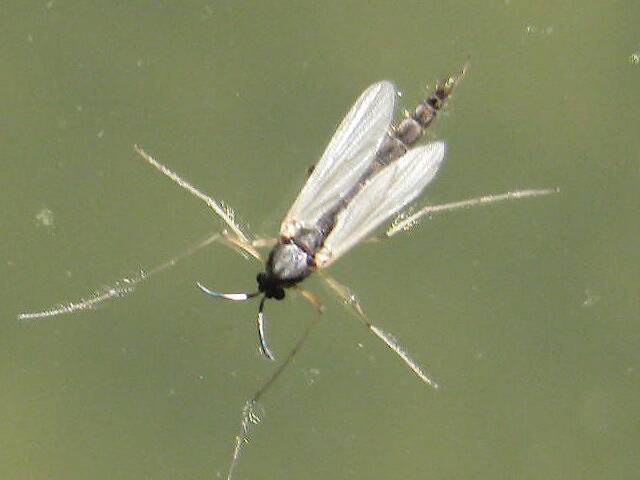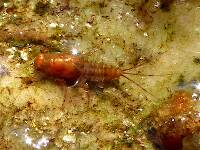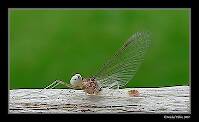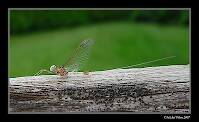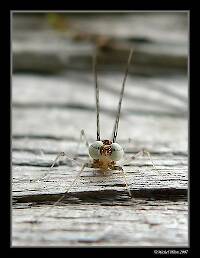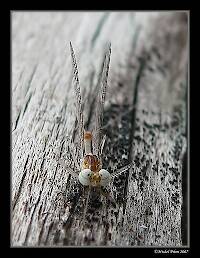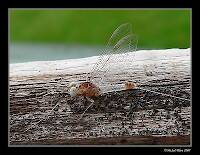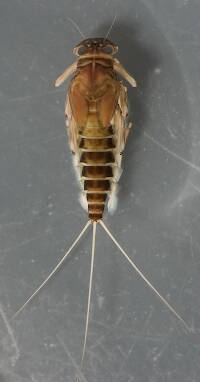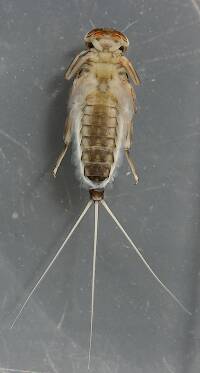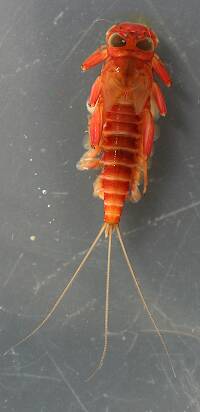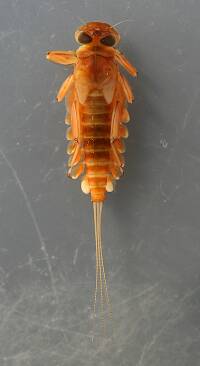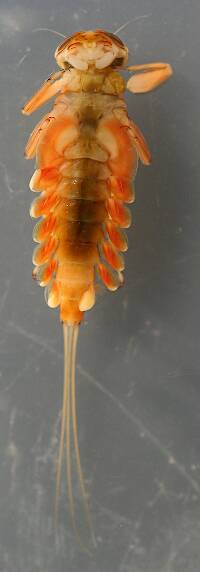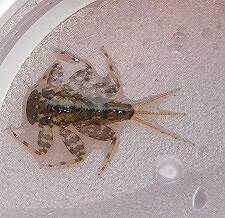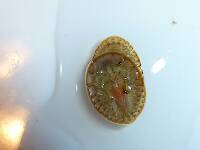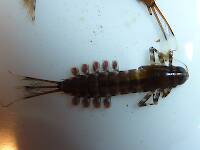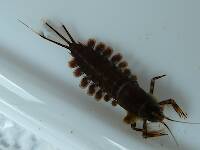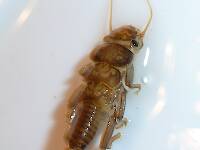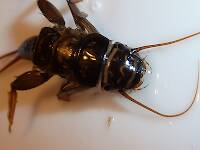
Blue-winged Olives
Baetis
Tiny Baetis mayflies are perhaps the most commonly encountered and imitated by anglers on all American trout streams due to their great abundance, widespread distribution, and trout-friendly emergence habits.
Featured on the forum

I was not fishing, but happened to be at an unrelated social event on a hill above this tiny creek (which I never even saw) when this stonefly flew by me. I assume it came from there. Some key characteristics are tricky to follow, but process of elimination ultimately led me to Sweltsa borealis. It is reassuringly similar to this specimen posted by Bob Newell years ago. It is also so strikingly similar to this nymph from the same river system that I'm comfortable identifying that nymph from this adult. I was especially pleased with the closeup photo of four mites parasitizing this one.

Troutnut is a project started in 2003 by salmonid ecologist Jason "Troutnut" Neuswanger to help anglers and
fly tyers unabashedly embrace the entomological side of the sport. Learn more about Troutnut or
support the project for an enhanced experience here.
Shepherdson has attached this picture to aid in identification. The message is below.
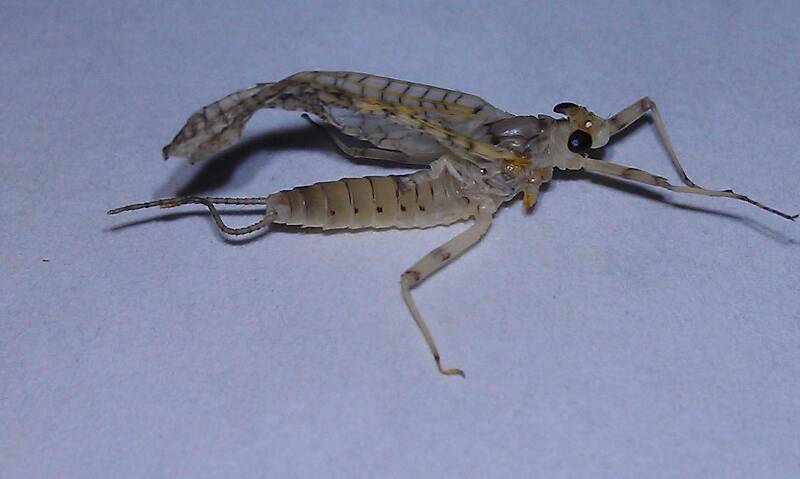
Shepherdson
Posts: 3
Posts: 3
Shepherdson on Apr 23, 2012April 23rd, 2012, 4:08 pm EDT
A buddy of mine got a shot of this freshly emerged Dun during a hatch on our local stream. East Ohio 4-22-12. The flying Duns appeared to be generally light / cream colored. My initial thought was Cahill or PMD. Any thoughts?
PaulRoberts on Apr 23, 2012April 23rd, 2012, 5:37 pm EDT
How big? Little early for Stenacron. Maybe M. ithaca? Looks too light for vicarium. We'll see what the experts say.
Wiflyfisher on Apr 23, 2012April 23rd, 2012, 6:02 pm EDT
Only 2 tails... Stenonema :-) They use to cover them all.
John S.
https://WiFlyFisher.com
https://WiFlyFisher.com
Wbranch on Apr 23, 2012April 23rd, 2012, 7:05 pm EDT
Absolutely not a PMD and I don't know bugs very well. Not the best photo I ever saw either. It looks more dead than alive. There seems to be quite a bit of veination in the wings so I'm thinking of some Stenonema.
Catskill fly fisher for fifty-five years.
Entoman on Apr 24, 2012April 24th, 2012, 12:46 am EDT
Welcome to the forum Shepherdson.
Well, I guess nothing should surprise me this year. This female looks to be Maccaffertium, probably pulchellum (Light Cahill). It normally shouldn't be showing itself until June.
A good look at the wing venation and a ventral view showing the subanal plate are normally necessary, but the spiracular dot count and pale banded mesonotum are pretty distinctive and fit the description.
Well, I guess nothing should surprise me this year. This female looks to be Maccaffertium, probably pulchellum (Light Cahill). It normally shouldn't be showing itself until June.
A good look at the wing venation and a ventral view showing the subanal plate are normally necessary, but the spiracular dot count and pale banded mesonotum are pretty distinctive and fit the description.
"It's not that I find fishing so important, it's just that I find all other endeavors of Man equally unimportant... And not nearly as much fun!" Robert Traver, Anatomy of a Fisherman
Konchu on Apr 24, 2012April 24th, 2012, 5:50 am EDT
Could it be Stenonema femoratum? Looks kind of like there is a distinct medial spot on each of the hind margins of abdominal terga.
Entoman on Apr 24, 2012April 24th, 2012, 9:18 am EDT
I don't think so, Luke. To my eyes the posterior margins medially look to be more or less covered with solid lines without distinct breaks. Also, to my understanding Stenonema doesn't have a spiracular dot pattern like this.
For the benefit of those that don't understand what we are discussing, adults of Stenonema are differentiated from all other Nearctic Heptageniinae by having abdominal terga 3-8 each with a median black dot and a pair of dark transverse dashes on the posterior margin. This specimen has terga with dark transverse lines at the posterior margins and w/ spiracular dots present on segs 3 - 7.
Due to the high variabilty in markings of Maccaffertium, I'm less confident in the species. A good look at the subanal plate and wings may help but the combination of dot count together with the unique banded color patterning of the meso and pale scutellum is described for pulchellum. Other similar species like modestum or mediopunctatum are described/diagrammed as having either different dot counts and/or darker (relative to the terga) and more uniformly patterned color schemes in the dorsal thoracic regions.
For the benefit of those that don't understand what we are discussing, adults of Stenonema are differentiated from all other Nearctic Heptageniinae by having abdominal terga 3-8 each with a median black dot and a pair of dark transverse dashes on the posterior margin. This specimen has terga with dark transverse lines at the posterior margins and w/ spiracular dots present on segs 3 - 7.
Due to the high variabilty in markings of Maccaffertium, I'm less confident in the species. A good look at the subanal plate and wings may help but the combination of dot count together with the unique banded color patterning of the meso and pale scutellum is described for pulchellum. Other similar species like modestum or mediopunctatum are described/diagrammed as having either different dot counts and/or darker (relative to the terga) and more uniformly patterned color schemes in the dorsal thoracic regions.
"It's not that I find fishing so important, it's just that I find all other endeavors of Man equally unimportant... And not nearly as much fun!" Robert Traver, Anatomy of a Fisherman
Konchu on Apr 24, 2012April 24th, 2012, 12:30 pm EDT
The smaller image looks different than the full-sized one on this computer, so I think I see what you mean, Entoman, but I'm not sure. Dunno.
Entoman on Apr 24, 2012April 24th, 2012, 3:50 pm EDT
Ah, when I drag the photo to enlarge it, there's not enough resolution to add to what I can see here - which looks like straight unbroken lines. I know that sometimes where the spots end and the dashes start can be so close that the character can be missed by unaided vision, and that might be going on here. Still, I can't explain the spiracular dots on 3 - 7 as I've never seen them look like that on Stenonema.
"It's not that I find fishing so important, it's just that I find all other endeavors of Man equally unimportant... And not nearly as much fun!" Robert Traver, Anatomy of a Fisherman
Konchu on Apr 24, 2012April 24th, 2012, 4:41 pm EDT
You're right about the spiracular marks.
Falsifly on Apr 24, 2012April 24th, 2012, 5:09 pm EDT
OK guys, are they "medial spots" or "spiracle dots"?
Falsifly
When asked what I just caught that monster on I showed him. He put on his magnifiers and said, "I can't believe they can see that."
When asked what I just caught that monster on I showed him. He put on his magnifiers and said, "I can't believe they can see that."
Entoman on Apr 24, 2012April 24th, 2012, 5:20 pm EDT
Two different types, Al. The medial spots we're talking about run down the center of the terga right at the posterior margin of each tergum. They break up the solid transverse lines into distinct dashes, one on each side of the dot. These are usually fairly distinct, but as Luke pointed out by raising the issue, in some specimens they can be much less so and harder to detect. I'm not seeing any with the resolution available on my screen. The spiracular dots are the ones running down the sides of the abdomen.
"It's not that I find fishing so important, it's just that I find all other endeavors of Man equally unimportant... And not nearly as much fun!" Robert Traver, Anatomy of a Fisherman
Falsifly on Apr 24, 2012April 24th, 2012, 5:47 pm EDT
Thanks Kurt, what had me going was:
I enlarged the photo from the file downloaded to my computer and couldn't see it and as a result I went into a brain fart. Even when I read your response: It didn't register.
Looks kind of like there is a distinct medial spot on each of the hind margins of abdominal terga.
I enlarged the photo from the file downloaded to my computer and couldn't see it and as a result I went into a brain fart. Even when I read your response:
Ah, when I drag the photo to enlarge it, there's not enough resolution to add to what I can see here - which looks like straight unbroken lines.
Falsifly
When asked what I just caught that monster on I showed him. He put on his magnifiers and said, "I can't believe they can see that."
When asked what I just caught that monster on I showed him. He put on his magnifiers and said, "I can't believe they can see that."
Entoman on Apr 24, 2012April 24th, 2012, 6:11 pm EDT
No problem. What got me going was Luke's comment because if you look close at the sixth tergal transverse band, it does have a slight widening medially and if you squint and turn your head slowly and blink twice, even the breaks appear.:) Some specimens aren't so easy...
"It's not that I find fishing so important, it's just that I find all other endeavors of Man equally unimportant... And not nearly as much fun!" Robert Traver, Anatomy of a Fisherman
Falsifly on Apr 24, 2012April 24th, 2012, 7:06 pm EDT
OK, so now you have me seeing things. I can't say that I see breaks,unless you mean a slight lightening in color, but it does appear to me that both the sixth and seventh tergal transverse bands have a lighter section between the lateral and medial portions. Maybe I'm starting to see what Luke was saying.
Falsifly
When asked what I just caught that monster on I showed him. He put on his magnifiers and said, "I can't believe they can see that."
When asked what I just caught that monster on I showed him. He put on his magnifiers and said, "I can't believe they can see that."
Shepherdson
Posts: 3
Posts: 3
Shepherdson on Apr 24, 2012April 24th, 2012, 7:56 pm EDT
Wow. Thanks for all the feedback everyone. Admittedly, most of it went about six inches over my head, but that's OK. I'm here to learn. Although it breaks from the flow of the post, could someone steer me toward a good ID resource(s) for Eastern flies?
Oh, and the mayflies were predominantly size #16 with a few larger and smaller. They were coming sporadically off the water (mostly from the riffles) from 4:00 all the way to lights out.
Oh, and the mayflies were predominantly size #16 with a few larger and smaller. They were coming sporadically off the water (mostly from the riffles) from 4:00 all the way to lights out.
PaulRoberts on Apr 25, 2012April 25th, 2012, 7:07 am EDT
Now that we have a size: Why not M ithaca? It's mighty early, they shortly followed vicarium in C NY.
Entoman on Apr 25, 2012April 25th, 2012, 7:31 am EDT
Hi Paul,
M. ithaca is noted for darker mesoscutellums and thick transverse tergal bands as opposed to the lines evidenced in this specimen. Spiracular dots are either absent or obscured by brown shadings. Also, they are not reported from OH with distribution limited to the Appalachian belt running from VT to TN.
M. ithaca is noted for darker mesoscutellums and thick transverse tergal bands as opposed to the lines evidenced in this specimen. Spiracular dots are either absent or obscured by brown shadings. Also, they are not reported from OH with distribution limited to the Appalachian belt running from VT to TN.
"It's not that I find fishing so important, it's just that I find all other endeavors of Man equally unimportant... And not nearly as much fun!" Robert Traver, Anatomy of a Fisherman
Konchu on Apr 25, 2012April 25th, 2012, 10:47 am EDT
M. ithaca has been reported from NE Ohio. I actually happened to have the paper open on my desk in front of me at the moment. That is unless those were shown to be misidentifications. I have not tried to track that down; just a quick response.
Entoman on Apr 25, 2012April 25th, 2012, 11:33 am EDT
Hi Luke,
My info is admittedly a little dated (Bednarik '79). In that paper, the range was expanded from previous belief that ithaca was endemic to the mountainous regions of central NY to encompass the swath of eastern mountainous country running from North to South. The authors did mention some Midwestern finds they believed dubious. Look forward to what you find out. Do you agree with my assessment of the characters though?
My info is admittedly a little dated (Bednarik '79). In that paper, the range was expanded from previous belief that ithaca was endemic to the mountainous regions of central NY to encompass the swath of eastern mountainous country running from North to South. The authors did mention some Midwestern finds they believed dubious. Look forward to what you find out. Do you agree with my assessment of the characters though?
"It's not that I find fishing so important, it's just that I find all other endeavors of Man equally unimportant... And not nearly as much fun!" Robert Traver, Anatomy of a Fisherman
Quick Reply
Related Discussions
Topic
Replies
Last Reply
5
Oct 17, 2007
by Pilonm
by Pilonm
13
Sep 14, 2011
by Jmd123
by Jmd123
6
Mar 12, 2015
by Feathers5
by Feathers5







